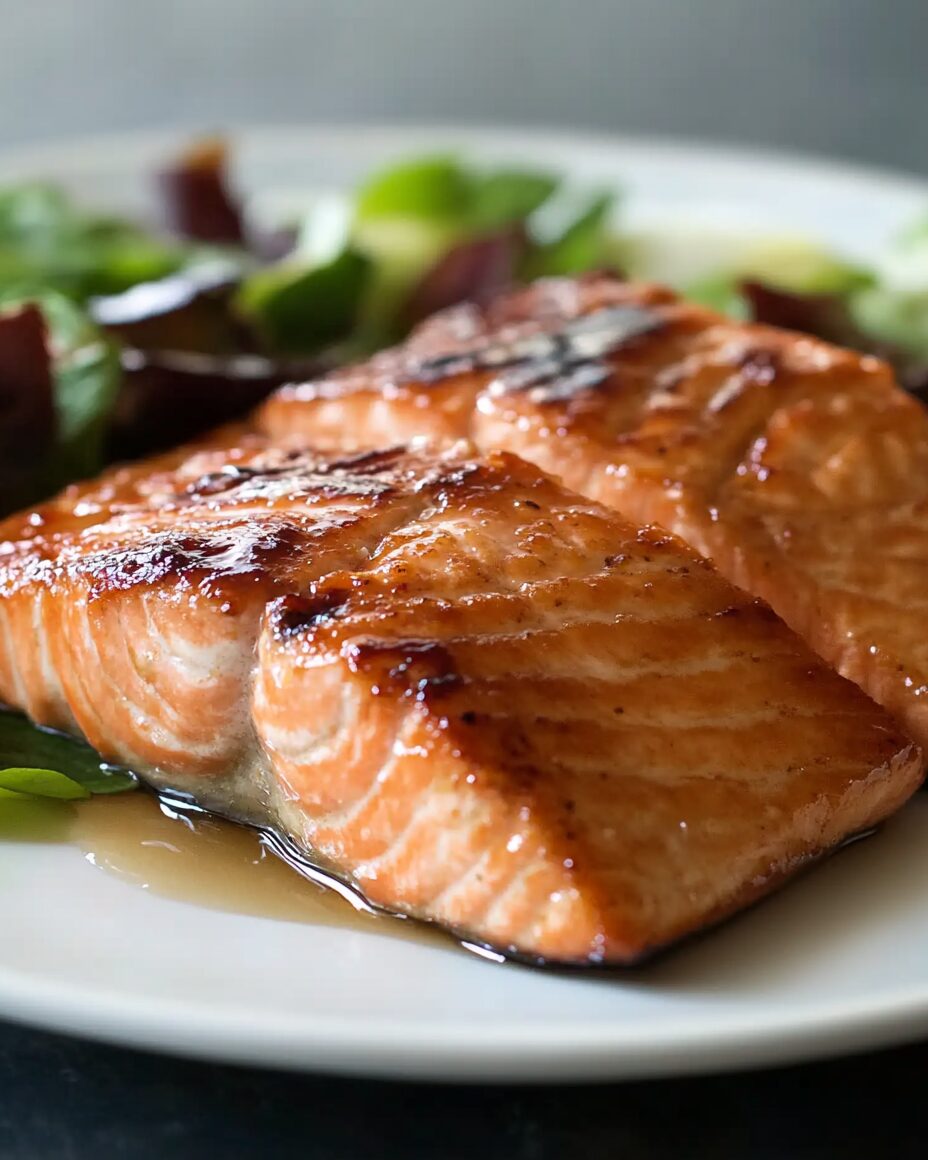This Easy Miso Salmon is the ultimate balance of sweet, salty, and umami flavors. The miso paste creates a delicious glaze, complemented by the warmth of sesame oil and the zing of fresh ginger. Paired with a tender, flaky salmon fillet, this dish is both nutritious and bursting with flavor. Ideal for busy weeknights, this recipe comes together in just 25 minutes, offering a quick yet impressive meal. Serve with rice or steamed vegetables for a light, wholesome dinner that will leave you feeling satisfied without weighing you down. Perfect for seafood lovers and fans of Japanese-inspired cuisine alike!
Full recipe:
Ingredients:
- 4 salmon fillets
- 1/4 cup miso paste (white or red)
- 2 tablespoons mirin
- 2 tablespoons rice vinegar
- 1 tablespoon soy sauce
- 1 tablespoon sesame oil
- 1 teaspoon grated ginger
- 2 tablespoons honey
- 1 tablespoon sesame seeds (optional)
- 2 green onions, chopped (for garnish)
Directions:
- Preheat the oven to 400°F (200°C).
- In a small bowl, whisk together the miso paste, mirin, rice vinegar, soy sauce, sesame oil, grated ginger, and honey until smooth.
- Place the salmon fillets on a baking sheet lined with parchment paper.
- Brush the miso glaze generously over each fillet.
- Bake the salmon for 12-15 minutes, or until the fish is flaky and cooked through.
- Optional: Sprinkle with sesame seeds and garnish with chopped green onions before serving.
Prep Time: 10 minutes | Cooking Time: 15 minutes | Total Time: 25 minutes
Kcal: 320 kcal | Servings: 4 servings
The Origins of Miso in Japanese Cuisine
Miso, a traditional Japanese ingredient, is at the heart of this recipe. Made from fermented soybeans, miso has been used in Japan for over a thousand years, prized for its savory depth (umami) and its versatility in a wide range of dishes. Historically, miso was considered a vital source of nutrition, especially during times when meat was scarce. It was often used in soups, marinades, and sauces to enhance flavor while providing essential nutrients.
The type of miso used in this recipe is usually white (shiro miso) or red (aka miso), both of which have subtle differences in flavor. White miso is milder and slightly sweet, while red miso has a more robust and salty taste. The combination of miso with other ingredients like ginger, soy sauce, and honey brings a complex, umami-rich profile to the salmon that’s both comforting and exciting.
Health Benefits of Salmon
Salmon is known for being one of the healthiest types of fish you can eat. It’s packed with omega-3 fatty acids, which are essential for heart health. Regular consumption of omega-3s can help reduce inflammation, lower blood pressure, and decrease the risk of heart disease. Salmon is also high in protein, making it a perfect choice for those looking to build or maintain muscle.
Additionally, salmon is rich in vitamins B12 and D, both of which play key roles in maintaining healthy bones, skin, and nerve function. Vitamin D is particularly beneficial for those living in areas with limited sunlight, as it helps regulate calcium and phosphorus absorption, contributing to stronger bones.
Combining salmon with the rich flavors of miso makes this dish not only delicious but also a powerhouse of nutrients, perfect for those aiming for a balanced diet.
Why Miso Salmon is the Best
- Quick and Easy
In today’s fast-paced world, finding a recipe that delivers on both taste and convenience is a game-changer. This Easy Miso Salmon recipe is designed to be as efficient as possible without compromising on flavor. With just a few ingredients and minimal prep, you can have a restaurant-quality meal on the table in under 30 minutes. - Flavor-Packed
The key to this recipe’s success lies in the miso marinade. Miso paste, combined with mirin (a sweet rice wine), soy sauce, sesame oil, ginger, and honey, creates a perfectly balanced glaze that coats the salmon, giving it a deep, savory flavor. The ginger adds a touch of warmth, while the honey brings just enough sweetness to counterbalance the salty richness of the miso. When baked, the glaze caramelizes slightly, giving the salmon a glossy, irresistible finish. - Versatile
This recipe is incredibly versatile, making it easy to adapt to different tastes and dietary needs. You can substitute other types of fish, like cod or halibut, if you prefer. It also pairs beautifully with a variety of sides. For a more traditional Japanese meal, serve it with steamed rice and miso soup. For a lighter option, a side of roasted or steamed vegetables, such as asparagus or bok choy, works just as well. The dish is also excellent when paired with a simple cucumber salad or pickled vegetables to provide a refreshing contrast to the rich flavors of the salmon. - A Nutrient-Dense Powerhouse
As mentioned, both salmon and miso come with impressive nutritional benefits. Salmon is a high-quality protein source that is rich in omega-3 fatty acids, which are essential for heart and brain health. Miso, being fermented, is also a good source of probiotics, which are beneficial for gut health. Together, these ingredients make this dish a great choice for anyone looking to eat healthily while enjoying a flavorful meal. - Suitable for Special Diets
This recipe can easily be adapted to suit different dietary preferences. For those who follow a gluten-free diet, simply use tamari instead of soy sauce. Vegetarians or those avoiding fish can use the miso glaze on tofu or roasted vegetables instead. The dish is naturally dairy-free and can be made entirely plant-based by replacing the salmon with a plant-based alternative.
Ideal for Any Occasion
The simplicity and elegance of the Easy Miso Salmon make it perfect for a variety of occasions. Whether you’re cooking a quick weeknight dinner or hosting friends for a special meal, this dish is sure to impress. The beautiful presentation, with the golden-brown glaze and sprinkling of sesame seeds and green onions, gives it a restaurant-worthy look, while the flavors are sophisticated enough to make it the star of any dinner table.
Cooking Tips for the Perfect Miso Salmon
- Use Fresh Salmon
Whenever possible, opt for fresh, high-quality salmon. The fresher the fish, the better the flavor and texture will be. Look for fillets that are firm, with a bright pink or orange hue and no fishy smell. - Do Not Overcook
Salmon cooks very quickly, and overcooking can result in a dry, tough texture. The key to perfectly cooked salmon is to watch it closely and remove it from the oven as soon as it becomes flaky. The internal temperature should reach around 145°F (63°C). - Customizing the Glaze
If you prefer a sweeter glaze, you can add more honey to the miso mixture. For those who enjoy a bit of heat, a pinch of red pepper flakes or a dash of sriracha can give the dish an extra kick. - Garnishing Ideas
While sesame seeds and green onions are the traditional garnishes, you can experiment with other toppings like shredded nori (seaweed), pickled ginger, or even a squeeze of fresh lemon juice to brighten up the flavors.
Environmental Impact and Sustainability
As awareness of sustainable eating grows, it’s important to consider the environmental impact of the seafood we consume. Salmon is one of the more sustainable fish options, especially when sourced from responsible fisheries or farms that prioritize the health of marine ecosystems. Choosing sustainably farmed or wild-caught salmon not only ensures you’re getting a quality product but also helps protect the environment.
Conclusion
This Easy Miso Salmon recipe is more than just a delicious meal; it’s a celebration of the best that both Japanese cuisine and seafood have to offer. Combining rich flavors, quick preparation, and nutritional benefits, it stands out as a top choice for anyone looking to enjoy a healthy, flavorful, and satisfying meal. Whether you’re an experienced home cook or just getting started, this recipe offers a simple yet impressive way to incorporate more fish into your diet while delighting your taste buds.
By making this dish, you’re not only treating yourself to a nutritious meal but also embracing a centuries-old tradition of Japanese culinary excellence.








